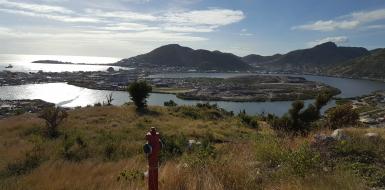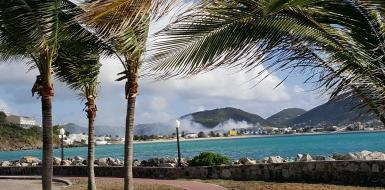At the beginning of 2019, RIVM measured the air quality around the landfill at Philipsburg, Sint Maarten, for two weeks. No, or hardly any harmful substances were measured. During the measurement period, there were no open fires at the landfill. As a result, RIVM was unable to assess the potential health risks of substances released in the event of an open fire at the landfill.
News
Air quality Sint Maarten landfill
At the beginning of 2019, RIVM measured the air quality around the landfill at Philipsburg, Sint Maarten for two weeks. No or hardly any harmful substances were measured.

RIVM will make measurements around the Sint Maarten landfill
From 21 January 2019, a team from RIVM will travel to Sint Maarten to make measurements and take samples at various locations around the landfill in Philipsburg.

The dense clouds of smoke generated by smouldering fires and occasional outbreaks of fire at the landfill affect many people in the vicinity. Over the longer term, it is not clear exactly what health risks these fires could pose. RIVM’s Environmental Incident Service has specialised equipment for making measurements and taking samples. Using these measurements and samples, RIVM will check whether certain substances have been released that are harmful to people’s health in the long term.
This measurement and risk assessment work will be carried out at the instruction of Sint Maarten’s Ministry of Public Housing, Spatial Planning, Environment and Infrastructure (VROMI). The investigation is being funded by the Ministry of the Interior and Kingdom Relations. RIVM’s team will spend at least two weeks in the area, taking samples and making measurements. If there are no outbreaks of fire during those two weeks, the team may extend its stay.
Measurements made and samples taken during smouldering fires and outbreaks of fire
RIVM will install equipment at the edge of the landfill for the purposes of making air measurements and taking air samples in relation to the continuously smouldering fires. This measuring and sampling work will be carried out in the course of two one-week periods.
If any outbreaks of fire occur, additional measuring sites will be set up. The exact locations of these sites will depend on factors such as the wind direction during an outbreak of fire. In the event of outbreaks of fire, RIVM will take various types of samples. In addition to swipe samples of settled dust, special canisters will be used to obtain air samples. Airborne particulate matter samples will be taken to measure particulate matter, for example, and, where appropriate, grass and/or crops will also be sampled.
The team always wears protective clothing when taking these types of samples, purely as a precaution. Any material collected will be stored under appropriate conditions.
Analysis and reporting procedures
The samples will be transported to the Netherlands in refrigerated containers. There, the samples will be analysed by various specialized laboratories at the RIKILT research institute in Wageningen, the Netherlands Organisation for Applied Scientific Research (TNO) and RIVM. These analyses will involve testing the samples for specific toxic substances that can be harmful to people’s health in the long term. These include Polycyclic Aromatic Hydrocarbons, dioxins, and heavy metals. Based on the results of these analyses, RIVM will then draw up a risk assessment.
RIVM will then submit a report, containing the results and its risk assessment, to the Ministry of Public Housing, Spatial Planning, Environment and Infrastructure. It will also publish the report on its website. This is currently scheduled for May 2019.
More information
- Website Government of Sint Maarten, Ministry of Public Housing, Spatial Planning, Environment and Infrastructure (VROMI)
- Voortgangsrapportage wederopbouw Sint Maarten BZK (Dutch only)
- Youtube channel Ministry of General Affairs
